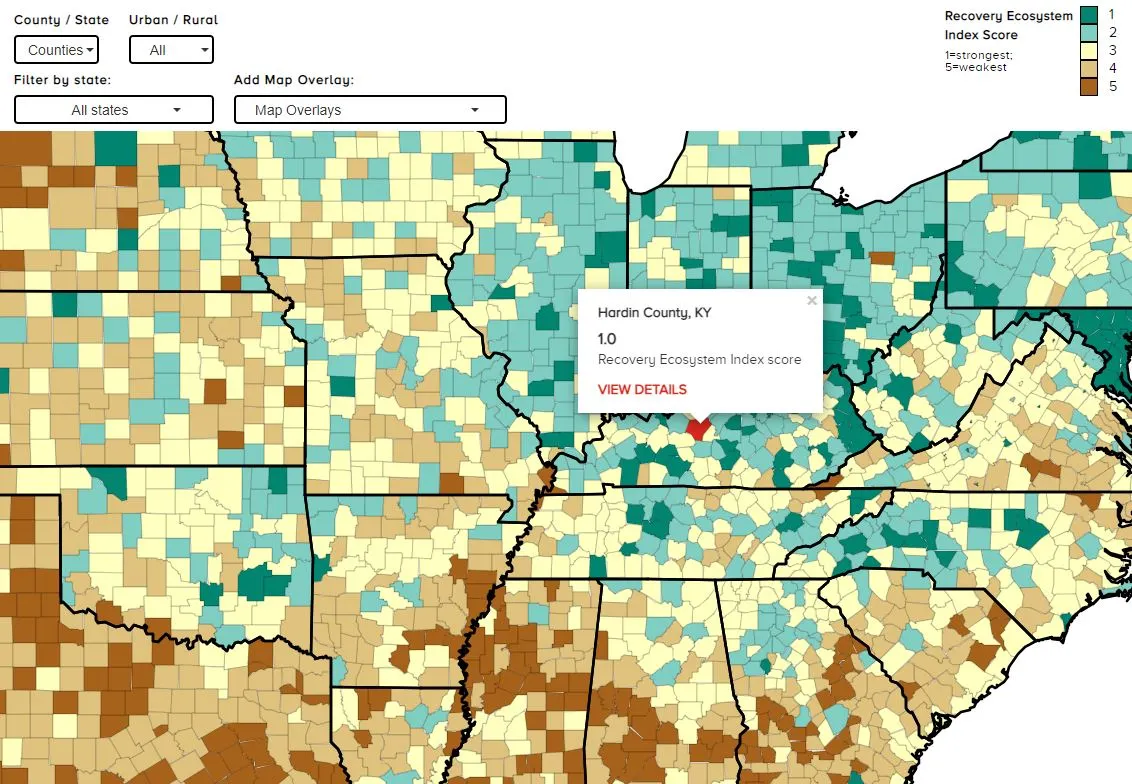Article Link: https://dailyyonder.com/how-ready-is-your-county-to-help-with-addiction-recovery/2022/11/08/
When officials in Vine Grove, Kentucky, put out a vending machine filled with free opioid overdose reversal medication, they expected people in the 7,000-person strong community would use it.
They just didn’t anticipate it being empty three days later.
“We put one machine out 27 days ago,” said Keith Mattingly, police chief of Vine Grove, located near Fort Knox about 25 miles southwest of Louisville. “Since then, we’ve gone through 169 boxes of Narcan.”
Narcan is a nasal spray version of Naloxone that reverses the effects of an opioid overdose. Giving it to an overdose victim can revive them within minutes.
In 2021, 2,250 Kentucky residents died of drug overdoses, a 14.5% increase over the previous year, the state’s Office of Drug Control Policy said. That includes 46 deaths in Hardin County, which includes Vine Grove. The increasing number of deaths in his community, spurred Mattingly to do something.
“I’m just out to save some people’s lives,” Mattingly said in an interview with the Daily Yonder.
According to the Centers for Disease Control and Prevention (CDC), drug overdose rates rose across the country in 2021, but in five states – California, Connecticut, North Carolina, Vermont and Virginia – drug overdose rates in rural counties were higher than in urban counties. Data from the CDC’s National Center for Health Statistics estimates that 107,622 Americans died from drug overdoses in 2021.
The Narcan vending machine is one example of how rural areas are addressing the drug use epidemic. A new national index from the Center for Rural Health Research at East Tennessee State University called the Recovery Ecosystem Index Mapping Tool drills down to the county level to assess drug recovery systems across the country.

The mapping tool, created in association with the National Opinion Research Center (NORC) at the University of Chicago and the Fletcher Group, shows the recovery resources available in every county in the United States. The index then rates each county by comparing resources and demographic information against the county’s overdose mortality rates.
“The index is intended to serve local stakeholders to help them better understand the availability of recovery-related resources in their county and neighboring counties,” said Andrew Howard with the Fletcher Group in an email interview.
Researchers hope the index can also be used to develop best practices for use in other communities, as well as be used by policymakers to better understand how services are distributed, and how they can target counties that lack resources.
Like this story? Get the latest from the Daily Yonder directly in your inbox, twice each week.
“We are hoping that people at the community level will use this tool to first determine the recovery ecosystem score for their community, but then to dig into the data to really understand where they can invest to create a better support system for their people,” said Michael Meit, co-director of the Center for Rural Health Research and one of the researchers on the project.
Meit said they found certain rural areas had greater success building out that recovery infrastructure. Although rural areas face more obstacles, he said, some are providing a better support system for their residents.
“To some extent, we expect to see lower scores in rural areas,” he said. “At the same time, there are places that do very, very well – in particular, Eastern Kentucky.”
There, the recovery ecosystem included access to harm reduction programs, a network of support programs, and engagement with the criminal justice system and other groups to support recovery, he said.

“Rural areas, I think, have more structural challenges, but (building a recovery ecosystem) is still eminently achievable in rural areas,” he said.
Former Kentucky governor Dr. Ernie Fletcher, founder and chief medical officer for the Fletcher Group, said the recovery index would help communities across the country access detailed information on how to work more effectively and more efficiently.
“This will be a game-changer for recovery allies all across the country,” Fletcher said in a statement. “That’s especially important because recovery ecosystems involve so many moving parts and rely so heavily on local resources. Having a quick, accurate, and detailed snapshot of what’s available—and what’s missing—will be a godsend, especially in the rural communities we serve.”
While the index was released in September, and missed the addition of Hardin County’s vending machine, Meit said researchers anticipate updating the index regularly.
In Hardin County, officials are getting a first-hand look at what a successful overdose reduction program looks like. Who is taking the vending machine Narcan? Mattingly said it varies.
“I’ve talked to elderly people who have addicted grandchildren,” Mattingly said. “They want to have it in case their grandchild overdoses at their house. We’ve had electrical contractors who’ve gotten them in case they come across someone overdosing when they go to a house. Are addicts coming to get them? There’s no way for us to know for sure, but I would assume so.”
So far, it looks like overdoses are down in the community, but he wasn’t going to draw conclusions until he had more data to compare it to, he said.
For now, though, he’s waiting until he can document one of his specially marked Narcan doses was used to reverse an overdose. Then, he said, he’ll know he’s done what he set out to do – save a life.
